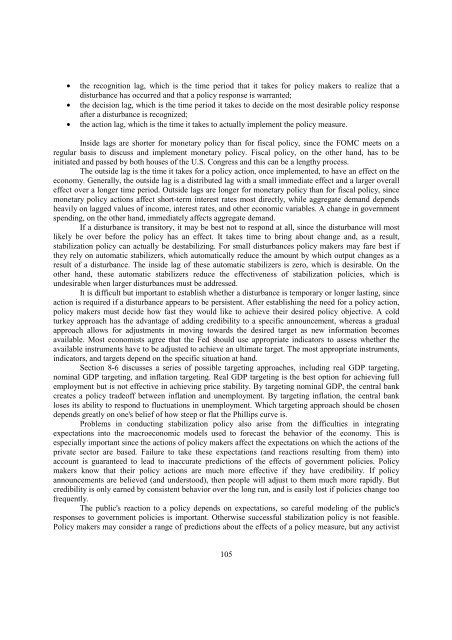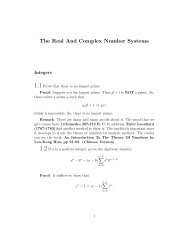Fiscal and monetary policy lags ⢠Automatic stabilizers ...
Fiscal and monetary policy lags ⢠Automatic stabilizers ...
Fiscal and monetary policy lags ⢠Automatic stabilizers ...
You also want an ePaper? Increase the reach of your titles
YUMPU automatically turns print PDFs into web optimized ePapers that Google loves.
• the recognition lag, which is the time period that it takes for <strong>policy</strong> makers to realize that adisturbance has occurred <strong>and</strong> that a <strong>policy</strong> response is warranted;• the decision lag, which is the time period it takes to decide on the most desirable <strong>policy</strong> responseafter a disturbance is recognized;• the action lag, which is the time it takes to actually implement the <strong>policy</strong> measure.Inside <strong>lags</strong> are shorter for <strong>monetary</strong> <strong>policy</strong> than for fiscal <strong>policy</strong>, since the FOMC meets on aregular basis to discuss <strong>and</strong> implement <strong>monetary</strong> <strong>policy</strong>. <strong>Fiscal</strong> <strong>policy</strong>, on the other h<strong>and</strong>, has to beinitiated <strong>and</strong> passed by both houses of the U.S. Congress <strong>and</strong> this can be a lengthy process.The outside lag is the time it takes for a <strong>policy</strong> action, once implemented, to have an effect on theeconomy. Generally, the outside lag is a distributed lag with a small immediate effect <strong>and</strong> a larger overalleffect over a longer time period. Outside <strong>lags</strong> are longer for <strong>monetary</strong> <strong>policy</strong> than for fiscal <strong>policy</strong>, since<strong>monetary</strong> <strong>policy</strong> actions affect short-term interest rates most directly, while aggregate dem<strong>and</strong> dependsheavily on lagged values of income, interest rates, <strong>and</strong> other economic variables. A change in governmentspending, on the other h<strong>and</strong>, immediately affects aggregate dem<strong>and</strong>.If a disturbance is transitory, it may be best not to respond at all, since the disturbance will mostlikely be over before the <strong>policy</strong> has an effect. It takes time to bring about change <strong>and</strong>, as a result,stabilization <strong>policy</strong> can actually be destabilizing. For small disturbances <strong>policy</strong> makers may fare best ifthey rely on automatic <strong>stabilizers</strong>, which automatically reduce the amount by which output changes as aresult of a disturbance. The inside lag of these automatic <strong>stabilizers</strong> is zero, which is desirable. On theother h<strong>and</strong>, these automatic <strong>stabilizers</strong> reduce the effectiveness of stabilization policies, which isundesirable when larger disturbances must be addressed.It is difficult but important to establish whether a disturbance is temporary or longer lasting, sinceaction is required if a disturbance appears to be persistent. After establishing the need for a <strong>policy</strong> action,<strong>policy</strong> makers must decide how fast they would like to achieve their desired <strong>policy</strong> objective. A coldturkey approach has the advantage of adding credibility to a specific announcement, whereas a gradualapproach allows for adjustments in moving towards the desired target as new information becomesavailable. Most economists agree that the Fed should use appropriate indicators to assess whether theavailable instruments have to be adjusted to achieve an ultimate target. The most appropriate instruments,indicators, <strong>and</strong> targets depend on the specific situation at h<strong>and</strong>.Section 8-6 discusses a series of possible targeting approaches, including real GDP targeting,nominal GDP targeting, <strong>and</strong> inflation targeting. Real GDP targeting is the best option for achieving fullemployment but is not effective in achieving price stability. By targeting nominal GDP, the central bankcreates a <strong>policy</strong> tradeoff between inflation <strong>and</strong> unemployment. By targeting inflation, the central bankloses its ability to respond to fluctuations in unemployment. Which targeting approach should be chosendepends greatly on one's belief of how steep or flat the Phillips curve is.Problems in conducting stabilization <strong>policy</strong> also arise from the difficulties in integratingexpectations into the macroeconomic models used to forecast the behavior of the economy. This isespecially important since the actions of <strong>policy</strong> makers affect the expectations on which the actions of theprivate sector are based. Failure to take these expectations (<strong>and</strong> reactions resulting from them) intoaccount is guaranteed to lead to inaccurate predictions of the effects of government policies. Policymakers know that their <strong>policy</strong> actions are much more effective if they have credibility. If <strong>policy</strong>announcements are believed (<strong>and</strong> understood), then people will adjust to them much more rapidly. Butcredibility is only earned by consistent behavior over the long run, <strong>and</strong> is easily lost if policies change toofrequently.The public's reaction to a <strong>policy</strong> depends on expectations, so careful modeling of the public'sresponses to government policies is important. Otherwise successful stabilization <strong>policy</strong> is not feasible.Policy makers may consider a range of predictions about the effects of a <strong>policy</strong> measure, but any activist105
















